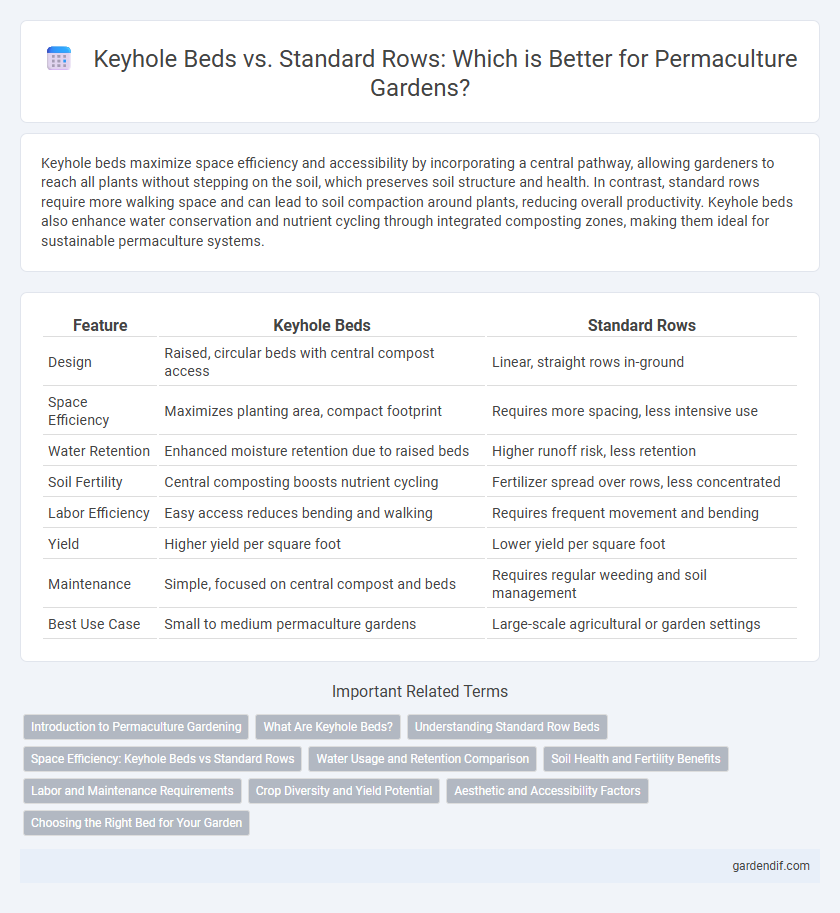
Keyhole Beds vs Standard Rows Illustration
Keyhole beds maximize space efficiency and accessibility by incorporating a central pathway, allowing gardeners to reach all plants without stepping on the soil, which preserves soil structure and health. In contrast, standard rows require more walking space and can lead to soil compaction around plants, reducing overall productivity. Keyhole beds also enhance water conservation and nutrient cycling through integrated composting zones, making them ideal for sustainable permaculture systems.
Table of Comparison
| Feature | Keyhole Beds | Standard Rows |
|---|---|---|
| Design | Raised, circular beds with central compost access | Linear, straight rows in-ground |
| Space Efficiency | Maximizes planting area, compact footprint | Requires more spacing, less intensive use |
| Water Retention | Enhanced moisture retention due to raised beds | Higher runoff risk, less retention |
| Soil Fertility | Central composting boosts nutrient cycling | Fertilizer spread over rows, less concentrated |
| Labor Efficiency | Easy access reduces bending and walking | Requires frequent movement and bending |
| Yield | Higher yield per square foot | Lower yield per square foot |
| Maintenance | Simple, focused on central compost and beds | Requires regular weeding and soil management |
| Best Use Case | Small to medium permaculture gardens | Large-scale agricultural or garden settings |
Introduction to Permaculture Gardening
Keyhole beds maximize space efficiency and plant accessibility by combining circular design with a central composting area, promoting nutrient recycling in permaculture gardening. Standard rows are simpler to implement but may lead to wasted space and increased soil compaction, reducing biodiversity and moisture retention. Incorporating keyhole beds supports sustainable water use and compost integration, central principles in permaculture design.
What Are Keyhole Beds?
Keyhole beds are circular raised garden beds with a central composting basket, designed to maximize space and improve soil fertility in permaculture systems. Their unique shape allows easy access to all plants without stepping into the bed, reducing soil compaction and enhancing root health. These beds optimize water retention and nutrient cycling, making them ideal for sustainable, efficient growing environments compared to standard rows.
Understanding Standard Row Beds
Standard row beds, commonly used in traditional agriculture, consist of long, narrow planting strips that facilitate easy access for planting, watering, and harvesting. These beds optimize space through linear organization but often require more walking paths, which can reduce overall growing area. They allow for efficient crop rotation and mechanization but may lack the microclimate benefits and intensive planting density characteristic of keyhole beds in permaculture design.
Space Efficiency: Keyhole Beds vs Standard Rows
Keyhole beds maximize space efficiency by combining circular pathways with a compact planting area, allowing access to all plants within a smaller footprint compared to traditional standard rows. The design minimizes wasted space between rows while enabling intensive planting and easy maintenance, increasing yield per square foot. Standard rows often require wider pathways for access, reducing overall productive area, making keyhole beds preferable for limited space gardening in permaculture systems.
Water Usage and Retention Comparison
Keyhole beds maximize water retention by incorporating a central composting basket that releases moisture and nutrients directly to plant roots, reducing the need for frequent irrigation. Standard rows rely heavily on surface watering, leading to higher evaporation and less efficient water use. This design in keyhole beds significantly lowers water consumption while enhancing soil moisture levels, making them ideal for water-scarce permaculture gardens.
Soil Health and Fertility Benefits
Keyhole beds enhance soil health and fertility by improving water retention and promoting diverse plant root interactions, which increase microbial activity and nutrient cycling compared to standard rows. The circular design minimizes soil compaction, allowing better aeration and organic matter decomposition, essential for sustaining soil vitality. Richer nutrient distribution in keyhole beds supports robust plant growth, leading to higher yields and long-term soil sustainability in permaculture systems.
Labor and Maintenance Requirements
Keyhole beds significantly reduce labor and maintenance requirements compared to standard rows due to their compact, circular design that maximizes planting area and minimizes walking paths. The central composting basket in keyhole beds enhances nutrient recycling, lowering the need for frequent fertilization and soil amendments. Standard rows demand more time for weeding, watering, and soil management because of their spread-out layout and lack of integrated composting systems.
Crop Diversity and Yield Potential
Keyhole beds maximize crop diversity by allowing multiple plant species to thrive in a compact, circular layout that improves microclimates and soil health. This design increases yield potential through efficient space utilization and easier access for maintenance, promoting healthier, more productive plants. In contrast, standard rows often limit crop variety and may reduce overall yield due to less efficient use of available space and soil resources.
Aesthetic and Accessibility Factors
Keyhole beds enhance garden aesthetics by creating a visually appealing, circular design that allows for efficient use of central composting within reach, compared to the linear layout of standard rows. The compact shape improves accessibility by reducing walking distance, making plant care easier for gardeners with limited mobility. Standard rows offer straightforward planting but lack the ergonomic and artistic benefits present in keyhole beds, impacting both garden functionality and visual harmony.
Choosing the Right Bed for Your Garden
Keyhole beds maximize space efficiency and accessibility by incorporating a central composting area, making them ideal for small or irregularly shaped gardens. Standard rows provide simplicity and ease of crop rotation, supporting large-scale planting and mechanized tools. Selecting the right bed design depends on garden size, maintenance practices, and crop diversity goals within permaculture systems.
Keyhole Beds vs Standard Rows Infographic

 gardendif.com
gardendif.com